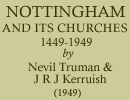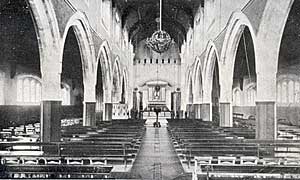
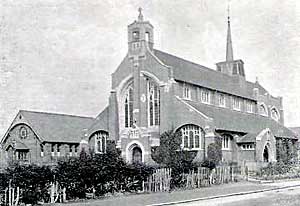
St Stephen's, Hyson Green.
St. Stephen's, Hyson Green, derives from a mission church called St. Simon's at the back of the present site. For a dozen years active spiritual work was carried on until an unexpected windfall made it possible to raise a permanent church. When the Victoria Station was being planned a large part of that neighbourhood was purchased, and it included an existing St. Stephen's church, Bunkers Hill, which had to be demolished to make room for the new railway line and station. The sale of church and glebe land furnished part of the endowment for Hyson Green and realised a sum of £10,000. Thus both funds and patron saint were provided from the same source. Much of the furniture comes from old St. Stephen's, including the pulpit, font, lectern and organ. The land was given by the Pearson Gregory family who made many generous benefactions for church work in the town.
Not that the residents have failed to pull their own weight. The altar and font cover are their gifts and the old organ was rebuilt in 1926 as a first world war memorial; additions are being made to commemorate the second world war.
Within the last three years three large benefactions have been given. Miss E. Hutchinson augmented the living by a capital sum of a thousand pounds and had the pleasure of doing this during her lifetime instead of making it as a bequest. Not content with this she left another thousand pounds by will, to be invested and the interest used for church expenses. A second legacy came from Mr. W. M. Hutchinson who started a Fabric Fund with a third thousand pounds. In this way a good financial basis is slowly being built up which will set free the way for further advance.
St. Christopher's, Sneinton, was a fine modern brick church in traditional Perpendicular Gothic, consecrated in 1902. It was left a shell after a German air raid on Nottingham in May, 1941. From the day after its destruction the parish set to work immediately upon the task of providing funds for the rebuilding. A booklet entitled Carry on—Christopher's! appeared in the same year. A temporary church within the ruins was opened in October, 1948.
St. Bartholomew's Church, built to serve the Blue Bell Hill area, is another modern church, consecrated in 1903.
St. Aidan's, Basford, was built in 1905 to meet the needs of the large area between Old Basford and Bulwell. It was undertaken by the Spiritual Aid Society from a legacy from Mr. George Waterall, a Nottingham chemist. It is in the Early English style with Decorated windows.
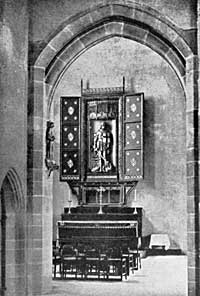
St George's chapel, Sneinton church.
St. Stephen's, Sneinton, though built by Bodley's successor, H. T. Hare, in 1912, is the fifth church on this site, which had one from medieval times. The 1839 tower by Rickman (one of the Gothic Revival pioneers and inventor of the terms "Norman", "Decorated", "Early English" and "Perpendicular") still remains.
Round this Hare created a stately stone edifice whose interior fittings are of the very finest in screens, stalls, statuary, reredoses and font cover. Much colour makes the whole place glow, notably on the tall spiral font cover, the towering reredos of the high altar with its carved scriptural scenes, the lovely modern Stations of the Cross, and the Rood. There are two good side altars with carved reredoses, and the chief glory is of course the fifteenth-century choir stalls ejected from St. Mary's in 1848 and secured for Sneinton by a perspicacious supporter of Sneinton Church. They have eight misericords with the usual quaint or humorous carvings underneath. There is a large painting of the Assumption by William Hilton and two others of the Italian School. This parish has for more than a century provided Church Schools, from whose scholars have come a bishop, a theatrical knight, and some other notables. The musical standard has been high throughout the same period, plainsong having been sung continuously since 1850 and in the middle Victorian age elaborate classical masses, often with orchestral accompaniment. The costly building was largely provided through the munificence of the Hon. R. M. Dalrymple, its then vicar, who was a cousin of Earl Manvers. The Manvers family had long been the patrons until they transferred the advowson to the Bishop. This church became widely known throughout the country during the vicariate of Canon Vernon Hutton, through his writings and the constant stream of famous priests who visited the church to preach. These included many of the Tractarian and Catholic Revival leaders, both in Hutton's time and that of his predecessor Mr. Wyatt, who built schools and vicarage and was a follower of the Oxford Movement as early as 1831. He started the first surpliced choir in the town in 1847.
St. Faith. This parish was constituted in 1914. The foundation stone of the new church had been laid by Lord Henry Bentinck, who had given generously to the work. The new parish, though entirely within the city boundaries, was formed out of the ancient parish of Wilford, and therefore it was styled "The Parish of St. Faith, North Wilford". This name is somewhat misleading as the district is part of the area always spoken of as "The Meadows", but the connection with Wilford is still kept alive by many of the street names in the parish, such as Wilford Road, Wilford Grove and Wilford Crescent. The new church was completed, with the exception of an aisle which was left boarded up, in the autumn of 1915. It is a fine and attractive building. The new aisle was completed in 1939, and work begun on a Parsonage blouse adjoining the church. The war stopped this when only the foundation stone had been laid.
St. Margaret's, Aspley, was formed as a separate district in 1933 from parts of the parishes of Old Radford, Wollaton, Old Basford, Bilborough and Cinderhill. A temporary church was dedicated in 1933, and the foundation stone of the present church laid in 1934 by Mrs. M. J. Player. The consecration took place in 1936. The architect was Mr. Heazell. The church was the gift of Mr. and Mrs. J. D. Player, who also provided the temporary building (now used as the Church Hall) and the Vicarage, and endowed the benefice. It is a light, lofty church built of brick and stone in a modern Gothic style, and serves an area which has been transformed in recent years from farms and fields into a well laid out housing area containing thousands of people and now reaching out to the former pretty lanes of Bilborough and Strelley.
St. Cyprian's, situated on the top of Carlton Hill, is a fine example of the adaptation of Romanesque to modern architecture. It has north and south ambulatories, rounded arches, and a spacious chancel and sanctuary. The variegated brickwork gives brightness to the interior, and this is increased by the plain glass of the lancet windows.
Unexpectedly, this church has various things of interest to the antiquary. The font is pre-Reformation. It depicts the seven Sacraments, but the details are obliterated by both time and exposure to the weather, for this ancient font was recovered from a field where (according to tradition) it had been flung by iconoclasts at the time of the Reformation.
A lovely and dignified statue of the Virgin stands under a canopy in the wall on the south side of the chancel. It was given to the church by Mr. Claude Howitt, the architect. Formerly dark with age and neglect, it was restored and repainted in 1947.
A Lady Chapel has been set up temporarily at the east end of the south ambulatory until a permanent chapel, provided for in the plan, can be built.
St. Cyprian's is the parish church of a large modern urban district.
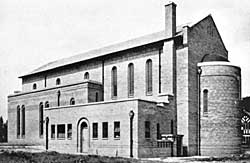
St Martin's, Sherwood.
St. Martin's, Sherwood, is situated in a pleasant road between Sherwood and Woodthorpe and serves that comparatively new residential and suburban area. It was consecrated in 1937. Mr. Heazell was the architect. As yet it is incomplete, for two bays of the nave and a campanile have to be built before the original design is completed. It has rapidly established itself as a very strong centre of Church life.
FOOTNOTE.—It was originally intended to provide an appendix containing the times of Sunday Services at Nottingham churches, hut unfortunately time did not allow the checking of this material. The information can, of course, he readily obtained from church notice boards or in parish magazines.
